airbag off Alfa Romeo Stelvio 2019 Owner's Manual
[x] Cancel search | Manufacturer: ALFA ROMEO, Model Year: 2019, Model line: Stelvio, Model: Alfa Romeo Stelvio 2019Pages: 244, PDF Size: 4.95 MB
Page 55 of 244
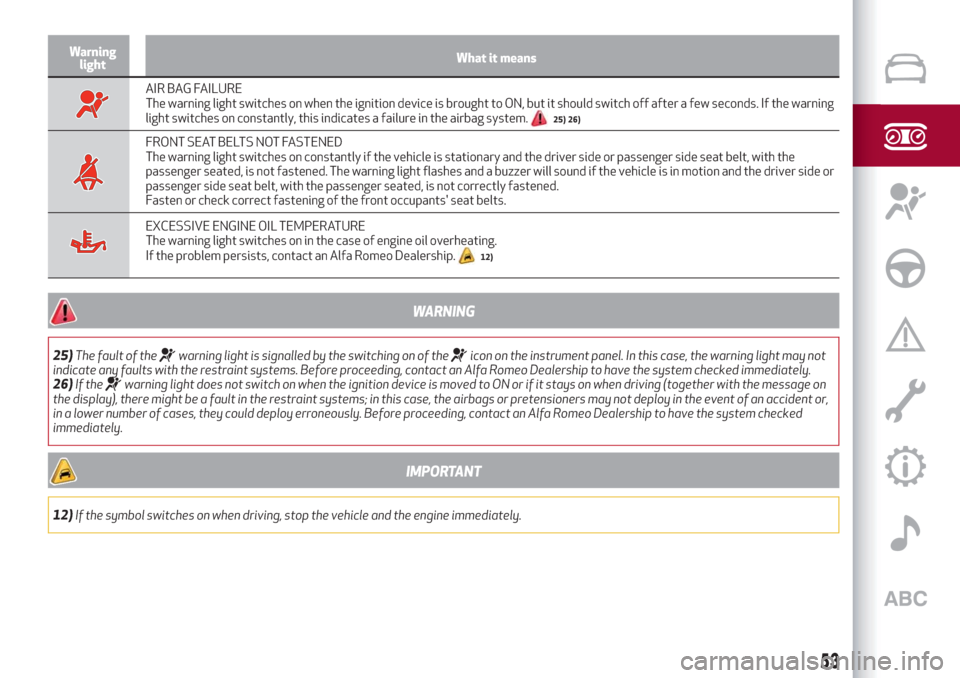
Warning
lightWhat it means
AIR BAG FAILURE
The warning light switches on when the ignition device is brought to ON, but it should switch off after a few seconds. If the warning
light switches on constantly, this indicates a failure in the airbag system.
25) 26)
FRONT SEAT BELTS NOT FASTENED
The warning light switches on constantly if the vehicle is stationary and the driver side or passenger side seat belt, with the
passenger seated, is not fastened. The warning light flashes and a buzzer will sound if the vehicle is in motion and the driver side or
passenger side seat belt, with the passenger seated, is not correctly fastened.
Fasten or check correct fastening of the front occupants' seat belts.
EXCESSIVE ENGINE OIL TEMPERATURE
The warning light switches on in the case of engine oil overheating.
If the problem persists, contact an Alfa Romeo Dealership.
12)
WARNING
25)The fault of thewarning light is signalled by the switching on of theicon on the instrument panel. In this case, the warning light may not
indicate any faults with the restraint systems. Before proceeding, contact an Alfa Romeo Dealership to have the system checked immediately.
26)If the
warning light does not switch on when the ignition device is moved to ON or if it stays on when driving (together with the message on
the display), there might be a fault in the restraint systems; in this case, the airbags or pretensioners may not deploy in the event of an accident or,
in a lower number of cases, they could deploy erroneously. Before proceeding, contact an Alfa Romeo Dealership to have the system checked
immediately.
IMPORTANT
12)If the symbol switches on when driving, stop the vehicle and the engine immediately.
53
Page 88 of 244
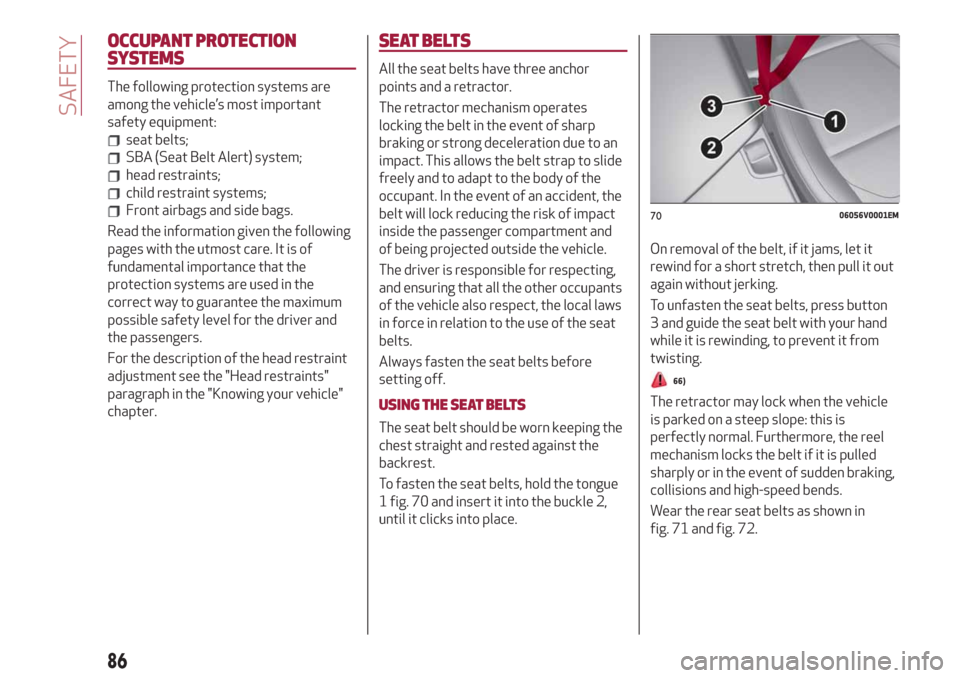
OCCUPANT PROTECTION
SYSTEMS
The following protection systems are
among the vehicle’s most important
safety equipment:
seat belts;
SBA (Seat Belt Alert) system;
head restraints;
child restraint systems;
Front airbags and side bags.
Read the information given the following
pages with the utmost care. It is of
fundamental importance that the
protection systems are used in the
correct way to guarantee the maximum
possible safety level for the driver and
the passengers.
For the description of the head restraint
adjustment see the "Head restraints"
paragraph in the "Knowing your vehicle"
chapter.
SEAT BELTS
All the seat belts have three anchor
points and a retractor.
The retractor mechanism operates
locking the belt in the event of sharp
braking or strong deceleration due to an
impact. This allows the belt strap to slide
freely and to adapt to the body of the
occupant. In the event of an accident, the
belt will lock reducing the risk of impact
inside the passenger compartment and
of being projected outside the vehicle.
The driver is responsible for respecting,
and ensuring that all the other occupants
of the vehicle also respect, the local laws
in force in relation to the use of the seat
belts.
Always fasten the seat belts before
setting off.
USING THE SEAT BELTS
The seat belt should be worn keeping the
chest straight and rested against the
backrest.
To fasten the seat belts, hold the tongue
1 fig. 70 and insert it into the buckle 2,
until it clicks into place.On removal of the belt, if it jams, let it
rewind for a short stretch, then pull it out
again without jerking.
To unfasten the seat belts, press button
3 and guide the seat belt with your hand
while it is rewinding, to prevent it from
twisting.
66)
The retractor may lock when the vehicle
is parked on a steep slope: this is
perfectly normal. Furthermore, the reel
mechanism locks the belt if it is pulled
sharply or in the event of sudden braking,
collisions and high-speed bends.
Wear the rear seat belts as shown in
fig. 71 and fig. 72.
7006056V0001EM
86
SAFETY
Page 96 of 244
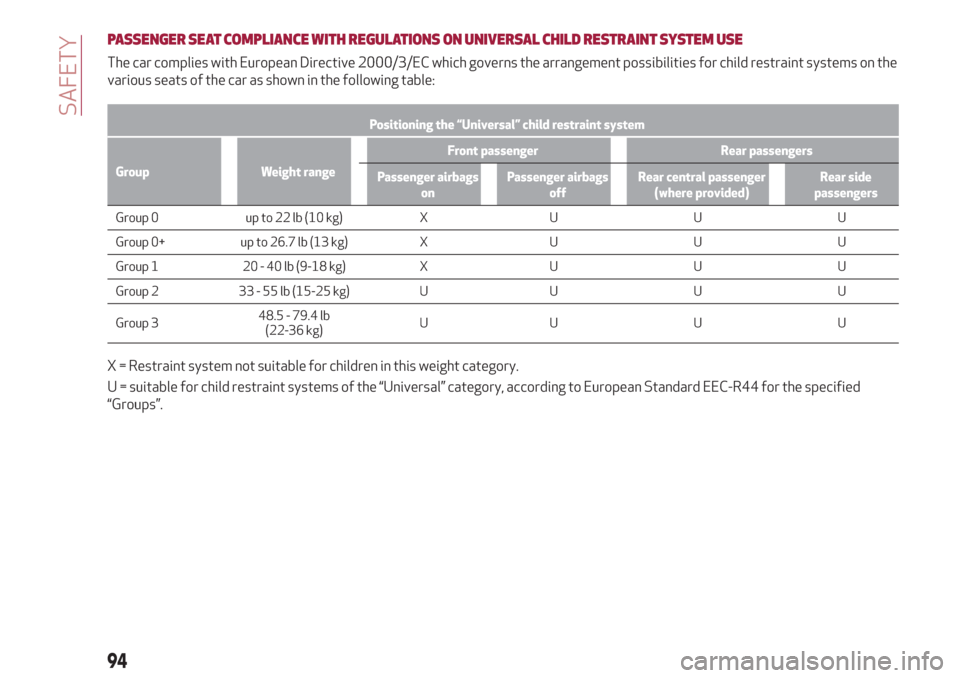
PASSENGER SEAT COMPLIANCE WITH REGULATIONS ON UNIVERSAL CHILD RESTRAINTSYSTEM USE
The car complies with European Directive 2000/3/EC which governs the arrangement possibilities for child restraint systems on the
various seats of the car as shown in the following table:
Positioning the “Universal” child restraint system
Group Weight rangeFront passenger Rear passengers
Passenger airbags
onPassenger airbags
offRear central passenger
(where provided)Rear side
passengers
Group 0 up to 22 lb (10 kg) X U U U
Group 0+ up to 26.7 lb (13 kg) X U U U
Group 1 20 - 40 lb (9-18 kg) X U U U
Group 2 33 - 55 lb (15-25 kg) U U U U
Group 348.5 - 79.4 lb
(22-36 kg)UUUU
X = Restraint system not suitable for children in this weight category.
U = suitable for child restraint systems of the “Universal” category, according to European Standard EEC-R44 for the specified
“Groups”.
94
SAFETY
Page 104 of 244

Main recommendations to carry
children safely
Install the child restraint systems on
the rear seat, which is the most protected
position in the event of an impact.
Keep children in rearward facing child
restraint systems for as long as possible,
until 3–4 years old if possible.
The rear head restraint or the front
passenger head restraint can be lifted if
needed to install a child restraint system.
The head restraint must always be
present in the vehicle and fitted if the
seat is used by an adult passenger or a
child sitting in a restraint system without
backrest (refer to the procedure
described in ‘’Head restraint’’ paragraph,
‘’Knowing your vehicle’’ chapter).
If the front passenger airbag has been
deactivated, always check that the
warning light on the courtesy light is on
continuously to make sure that it is
effectively deactivated.
Carefully follow the instructions
supplied with the child restraint system.
Keep the instructions in the vehicle along
with the other documents and this
handbook. Do not use second-hand child
seats without instructions.
Only one child is to be strapped into
each restraint system; never carry two
children using one child restraint system.
Always check that the seat belts do
not rest on the child’s neck.
Always check that the seat belt is well
fastened by pulling on it.
While travelling, do not let the child sit
incorrectly or unfasten the belts.
Never allow a child to put the belt's
diagonal section under an arm or behind
their back.
Never carry children on your lap, even
newborns. No-one can hold a child in the
case of a crash.
In the event of an accident, replace the
child restraint system with a new one.
WARNING
74)SEVERE DANGER When a front
passenger airbag is fitted, do not install
rearward facing child restraint systems on
the front passenger seat. Deployment of the
airbag in an accident could cause fatal
injuries to the child regardless of the
severity of the collision. It is advisable to
always carry children in a child restraint
system on the rear seat, which is the most
protected position in the event of a collision.
75)On the sun visor there is a label with
suitable symbols reminding the user that it is
compulsory to deactivate the airbag if a
rearward facing child restraint system is
fitted. Always comply with the instructions
on the passenger side sun visor (see the
"Supplementary Restraint System (SRS) -
Airbag" paragraph).76)Should it be necessary to carry a child on
the passenger side front seat in a rear facing
child restraint system, the passenger side
front airbag and side bag must be
deactivated through the Connect system
main menu (see the Supplementary
Restraint System (SRS) - Airbag"
paragraph), verifying deactivation by
checking whether the
OFFLED has
illuminated on the front ceiling light. Move
the passenger's seat as far back as possible
to avoid contact between the child seat and
the dashboard.
77)Do not move the front or rear seat if a
child is seated on it or on the dedicated child
restraint system
78)Incorrect fitting of the child restraint
system may result in an inefficient
protection system. In the event of an
accident the child restraint system may
become loose and the child may be injured,
even fatally. When fitting a restraint system
for newborns or children, strictly comply
with the instructions provided by the
Manufacturer.
79)When the child restraint system is not
used, secure it with the seat belt or with the
ISOFIX anchorages, or remove it from the
vehicle. Do not leave it unsecured inside the
passenger compartment. In this way, in the
case of sudden braking or an accident, it will
not cause injuries to the occupants.
80)After installing a child restraint system,
do not move the seat: always remove the
child restraint system before making any
adjustment.
102
SAFETY
Page 105 of 244
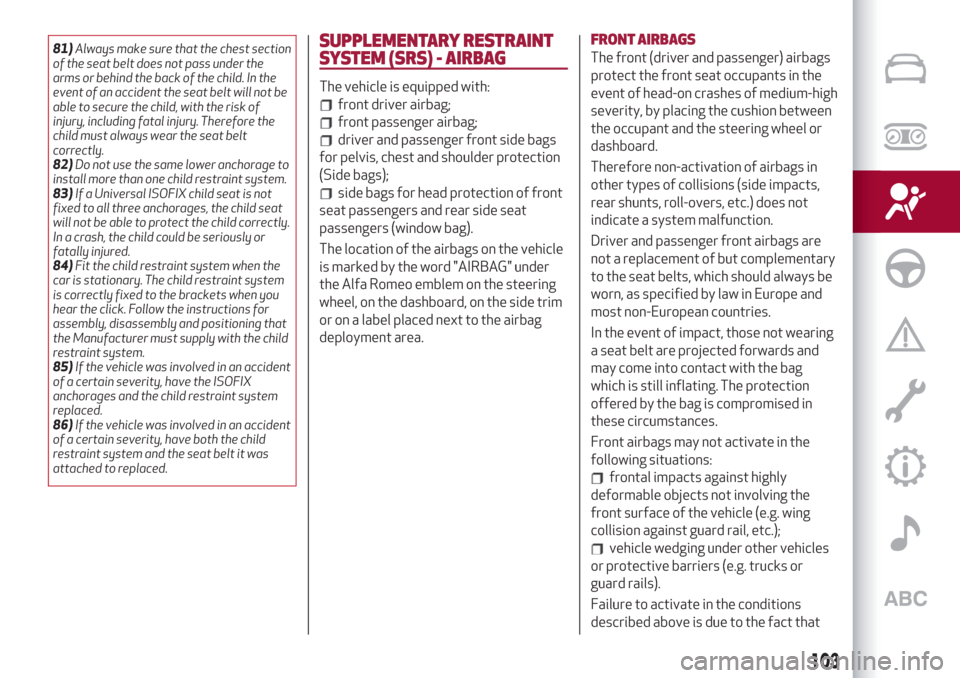
81)Always make sure that the chest section
of the seat belt does not pass under the
arms or behind the back of the child. In the
event of an accident the seat belt will not be
able to secure the child, with the risk of
injury, including fatal injury. Therefore the
child must always wear the seat belt
correctly.
82)Do not use the same lower anchorage to
install more than one child restraint system.
83)If a Universal ISOFIX child seat is not
fixed to all three anchorages, the child seat
will not be able to protect the child correctly.
In a crash, the child could be seriously or
fatally injured.
84)Fit the child restraint system when the
car is stationary. The child restraint system
is correctly fixed to the brackets when you
hear the click. Follow the instructions for
assembly, disassembly and positioning that
the Manufacturer must supply with the child
restraint system.
85)If the vehicle was involved in an accident
of a certain severity, have the ISOFIX
anchorages and the child restraint system
replaced.
86)If the vehicle was involved in an accident
of a certain severity, have both the child
restraint system and the seat belt it was
attached to replaced.SUPPLEMENTARY RESTRAINT
SYSTEM (SRS) - AIRBAG
The vehicle is equipped with:
front driver airbag;
front passenger airbag;
driver and passenger front side bags
for pelvis, chest and shoulder protection
(Side bags);
side bags for head protection of front
seat passengers and rear side seat
passengers (window bag).
The location of the airbags on the vehicle
is marked by the word "AIRBAG" under
the Alfa Romeo emblem on the steering
wheel, on the dashboard, on the side trim
or on a label placed next to the airbag
deployment area.
FRONT AIRBAGS
The front (driver and passenger) airbags
protect the front seat occupants in the
event of head-on crashes of medium-high
severity, by placing the cushion between
the occupant and the steering wheel or
dashboard.
Therefore non-activation of airbags in
other types of collisions (side impacts,
rear shunts, roll-overs, etc.) does not
indicate a system malfunction.
Driver and passenger front airbags are
not a replacement of but complementary
to the seat belts, which should always be
worn, as specified by law in Europe and
most non-European countries.
In the event of impact, those not wearing
a seat belt are projected forwards and
may come into contact with the bag
which is still inflating. The protection
offered by the bag is compromised in
these circumstances.
Front airbags may not activate in the
following situations:
frontal impacts against highly
deformable objects not involving the
front surface of the vehicle (e.g. wing
collision against guard rail, etc.);
vehicle wedging under other vehicles
or protective barriers (e.g. trucks or
guard rails).
Failure to activate in the conditions
described above is due to the fact that
103
Page 107 of 244

Deactivating/activating the passenger
side airbags: front airbag and side bag
(where provided)
To deactivate the front and side
passenger side airbag, use the Connect
system. Select the following functions in
succession from the main Menu, and
activate them by pressing the MENU
fig. 91 button: “Settings", "Safety", "Front
Passenger Airbag". They can be selected
by turning and pressing the Rotary Pad.
The system informs you of the
activation/deactivation status of the
airbags and asks for confirmation of the
status change. Press the Rotary Pad if
you want to proceed.On the dashboard are the ON and OFF
LED status. Moving the ignition device to
MAR, the two LEDs switch on for a few
seconds. If not, contact an Alfa Romeo
Dealership. During the first seconds, the
activation of the LEDs does not actually
show the passenger protection status,
but only checks its correct operation.
After a test of a few seconds, the LEDs
will indicate the status of the passenger
airbag protection.
Passenger protection activated: the ON
LED fig. 92 switches on fixed.
Passenger protection deactivated: the
OFF LED turns on fixed.
9105036V0040EM9206106S0008EM
105
Page 110 of 244
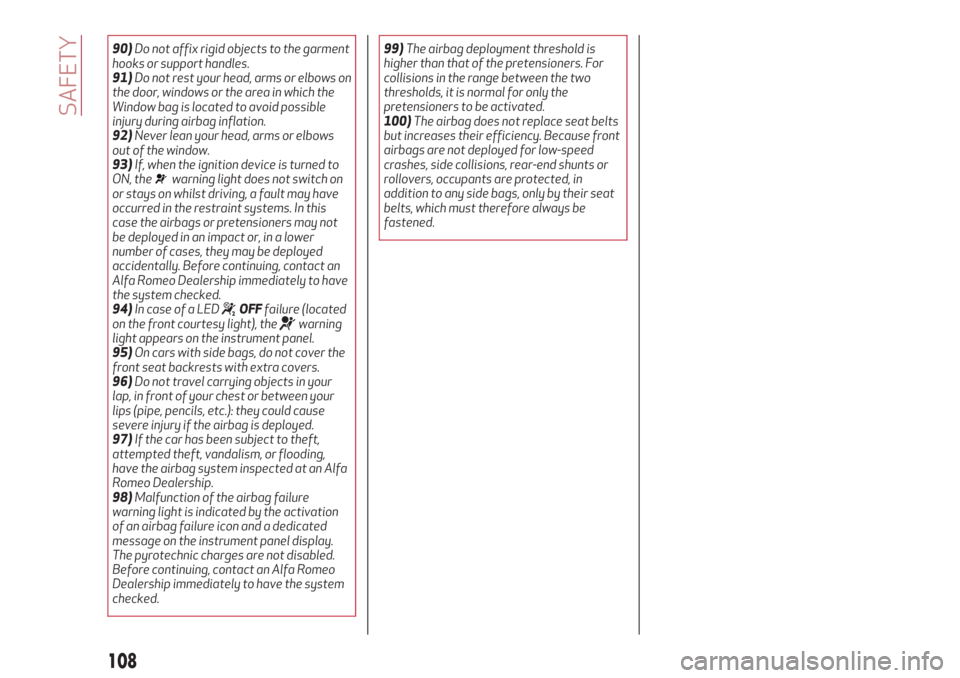
90)Do not affix rigid objects to the garment
hooks or support handles.
91)Do not rest your head, arms or elbows on
the door, windows or the area in which the
Window bag is located to avoid possible
injury during airbag inflation.
92)Never lean your head, arms or elbows
out of the window.
93)If, when the ignition device is turned to
ON, the
warning light does not switch on
or stays on whilst driving, a fault may have
occurred in the restraint systems. In this
case the airbags or pretensioners may not
be deployed in an impact or, in a lower
number of cases, they may be deployed
accidentally. Before continuing, contact an
Alfa Romeo Dealership immediately to have
the system checked.
94)In case of a LED
OFFfailure (located
on the front courtesy light), thewarning
light appears on the instrument panel.
95)On cars with side bags, do not cover the
front seat backrests with extra covers.
96)Do not travel carrying objects in your
lap, in front of your chest or between your
lips (pipe, pencils, etc.): they could cause
severe injury if the airbag is deployed.
97)If the car has been subject to theft,
attempted theft, vandalism, or flooding,
have the airbag system inspected at an Alfa
Romeo Dealership.
98)Malfunction of the airbag failure
warning light is indicated by the activation
of an airbag failure icon and a dedicated
message on the instrument panel display.
The pyrotechnic charges are not disabled.
Before continuing, contact an Alfa Romeo
Dealership immediately to have the system
checked.99)The airbag deployment threshold is
higher than that of the pretensioners. For
collisions in the range between the two
thresholds, it is normal for only the
pretensioners to be activated.
100)The airbag does not replace seat belts
but increases their efficiency. Because front
airbags are not deployed for low-speed
crashes, side collisions, rear-end shunts or
rollovers, occupants are protected, in
addition to any side bags, only by their seat
belts, which must therefore always be
fastened.
108
SAFETY
Page 159 of 244
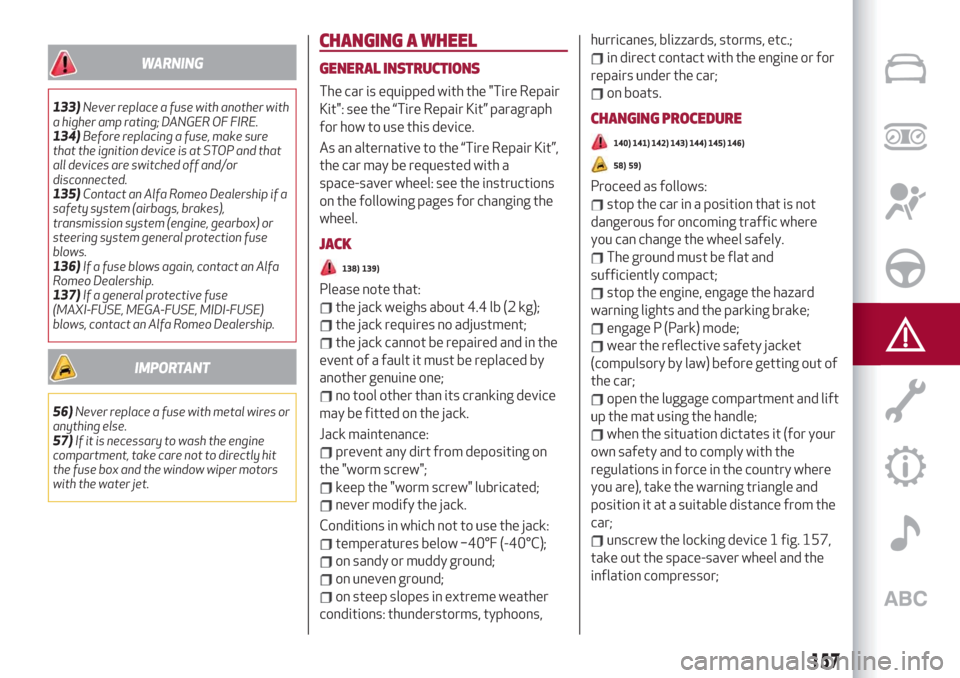
WARNING
133)Never replace a fuse with another with
a higher amp rating; DANGER OF FIRE.
134)Before replacing a fuse, make sure
that the ignition device is at STOP and that
all devices are switched off and/or
disconnected.
135)Contact an Alfa Romeo Dealership if a
safety system (airbags, brakes),
transmission system (engine, gearbox) or
steering system general protection fuse
blows.
136)If a fuse blows again, contact an Alfa
Romeo Dealership.
137)If a general protective fuse
(MAXI-FUSE, MEGA-FUSE, MIDI-FUSE)
blows, contact an Alfa Romeo Dealership.
IMPORTANT
56)Never replace a fuse with metal wires or
anything else.
57)If it is necessary to wash the engine
compartment, take care not to directly hit
the fuse box and the window wiper motors
with the water jet.
CHANGING A WHEEL
GENERAL INSTRUCTIONS
The car is equipped with the "Tire Repair
Kit": see the “Tire Repair Kit” paragraph
for how to use this device.
As an alternative to the “Tire Repair Kit”,
the car may be requested with a
space-saver wheel: see the instructions
on the following pages for changing the
wheel.
JACK
138) 139)
Please note that:
the jack weighs about 4.4 lb (2 kg);
the jack requires no adjustment;
the jack cannot be repaired and in the
event of a fault it must be replaced by
another genuine one;
no tool other than its cranking device
may be fitted on the jack.
Jack maintenance:
prevent any dirt from depositing on
the "worm screw";
keep the "worm screw" lubricated;
never modify the jack.
Conditions in which not to use the jack:
temperatures below −40°F (-40°C);
on sandy or muddy ground;
on uneven ground;
on steep slopes in extreme weather
conditions: thunderstorms, typhoons,hurricanes, blizzards, storms, etc.;
in direct contact with the engine or for
repairs under the car;
on boats.
CHANGING PROCEDURE
140) 141) 142) 143) 144) 145) 146)
58) 59)
Proceed as follows:
stop the car in a position that is not
dangerous for oncoming traffic where
you can change the wheel safely.
The ground must be flat and
sufficiently compact;
stop the engine, engage the hazard
warning lights and the parking brake;
engage P (Park) mode;
wear the reflective safety jacket
(compulsory by law) before getting out of
the car;
open the luggage compartment and lift
up the mat using the handle;
when the situation dictates it (for your
own safety and to comply with the
regulations in force in the country where
you are), take the warning triangle and
position it at a suitable distance from the
car;
unscrew the locking device 1 fig. 157,
take out the space-saver wheel and the
inflation compressor;
157
Page 167 of 244
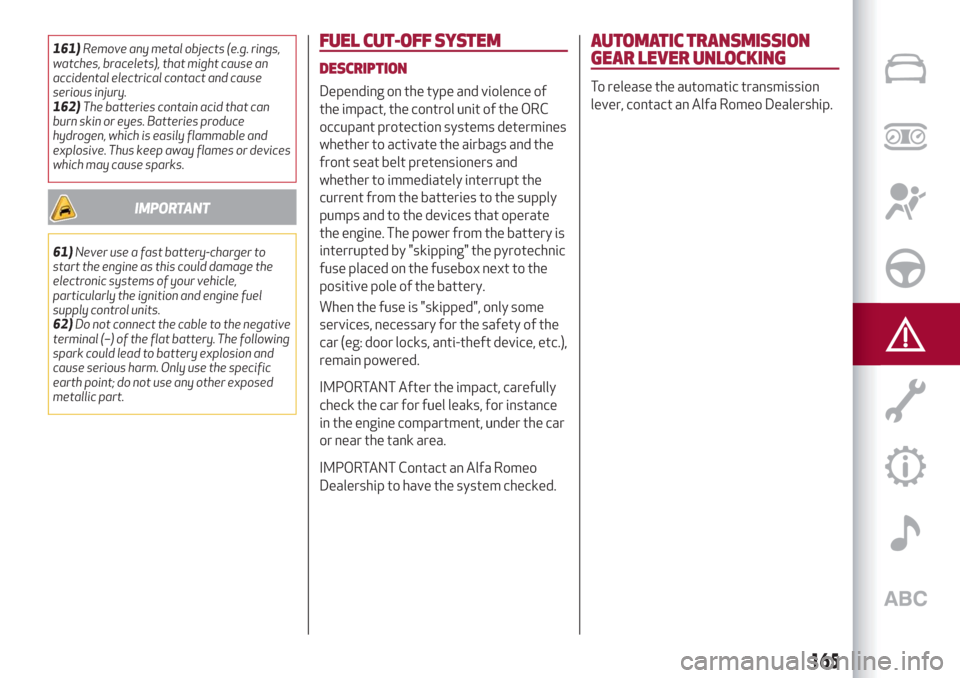
161)Remove any metal objects (e.g. rings,
watches, bracelets), that might cause an
accidental electrical contact and cause
serious injury.
162)The batteries contain acid that can
burn skin or eyes. Batteries produce
hydrogen, which is easily flammable and
explosive. Thus keep away flames or devices
which may cause sparks.
IMPORTANT
61)Never use a fast battery-charger to
start the engine as this could damage the
electronic systems of your vehicle,
particularly the ignition and engine fuel
supply control units.
62)Do not connect the cable to the negative
terminal (–) of the flat battery. The following
spark could lead to battery explosion and
cause serious harm. Only use the specific
earth point; do not use any other exposed
metallic part.
FUEL CUT-OFFSYSTEM
DESCRIPTION
Depending on the type and violence of
the impact, the control unit of the ORC
occupant protection systems determines
whether to activate the airbags and the
front seat belt pretensioners and
whether to immediately interrupt the
current from the batteries to the supply
pumps and to the devices that operate
the engine. The power from the battery is
interrupted by "skipping" the pyrotechnic
fuse placed on the fusebox next to the
positive pole of the battery.
When the fuse is "skipped", only some
services, necessary for the safety of the
car (eg: door locks, anti-theft device, etc.),
remain powered.
IMPORTANT After the impact, carefully
check the car for fuel leaks, for instance
in the engine compartment, under the car
or near the tank area.
IMPORTANT Contact an Alfa Romeo
Dealership to have the system checked.
AUTOMATIC TRANSMISSION
GEAR LEVER UNLOCKING
To release the automatic transmission
lever, contact an Alfa Romeo Dealership.
165
Page 227 of 244
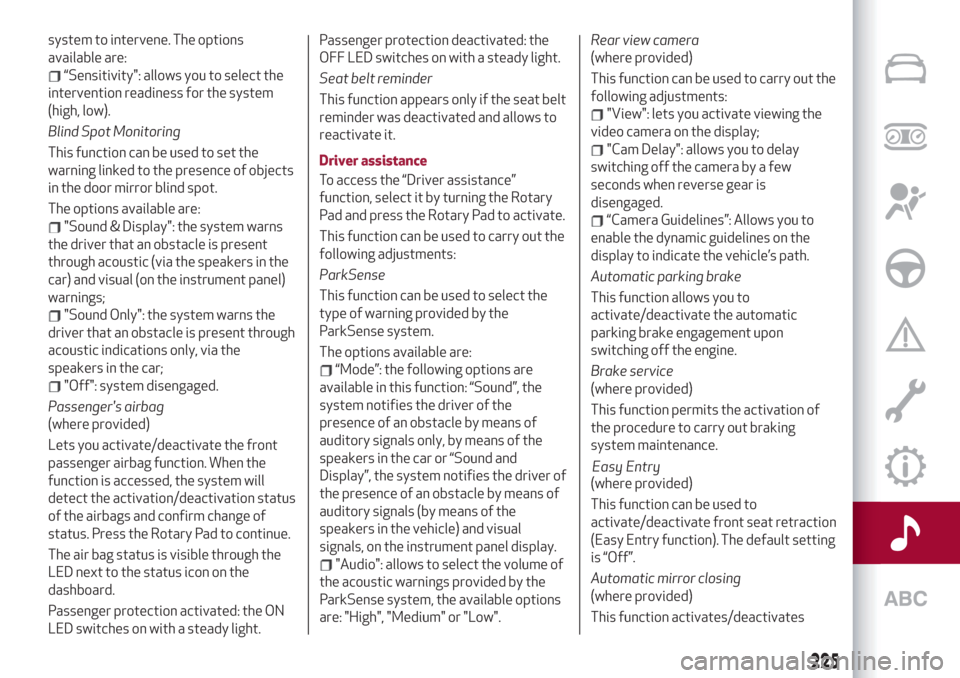
system to intervene. The options
available are:
“Sensitivity": allows you to select the
intervention readiness for the system
(high, low).
Blind Spot Monitoring
This function can be used to set the
warning linked to the presence of objects
in the door mirror blind spot.
The options available are:
"Sound & Display": the system warns
the driver that an obstacle is present
through acoustic (via the speakers in the
car) and visual (on the instrument panel)
warnings;
"Sound Only": the system warns the
driver that an obstacle is present through
acoustic indications only, via the
speakers in the car;
"Off": system disengaged.
Passenger's airbag
(where provided)
Lets you activate/deactivate the front
passenger airbag function. When the
function is accessed, the system will
detect the activation/deactivation status
of the airbags and confirm change of
status. Press the Rotary Pad to continue.
The air bag status is visible through the
LED next to the status icon on the
dashboard.
Passenger protection activated: the ON
LED switches on with a steady light.Passenger protection deactivated: the
OFF LED switches on with a steady light.
Seat belt reminder
This function appears only if the seat belt
reminder was deactivated and allows to
reactivate it.
Driver assistance
To access the “Driver assistance”
function, select it by turning the Rotary
Pad and press the Rotary Pad to activate.
This function can be used to carry out the
following adjustments:
ParkSense
This function can be used to select the
type of warning provided by the
ParkSense system.
The options available are:“Mode”: the following options are
available in this function: “Sound”, the
system notifies the driver of the
presence of an obstacle by means of
auditory signals only, by means of the
speakers in the car or “Sound and
Display”, the system notifies the driver of
the presence of an obstacle by means of
auditory signals (by means of the
speakers in the vehicle) and visual
signals, on the instrument panel display.
"Audio": allows to select the volume of
the acoustic warnings provided by the
ParkSense system, the available options
are: "High", "Medium" or "Low".Rear view camera
(where provided)
This function can be used to carry out the
following adjustments:
"View": lets you activate viewing the
video camera on the display;
"Cam Delay": allows you to delay
switching off the camera by a few
seconds when reverse gear is
disengaged.
“Camera Guidelines”: Allows you to
enable the dynamic guidelines on the
display to indicate the vehicle’s path.
Automatic parking brake
This function allows you to
activate/deactivate the automatic
parking brake engagement upon
switching off the engine.
Brake service
(where provided)
This function permits the activation of
the procedure to carry out braking
system maintenance.
(where provided)
This function can be used to
activate/deactivate front seat retraction
(Easy Entry function). The default setting
is “Off”.
Automatic mirror closing
(where provided)
This function activates/deactivates
225
Easy Entry